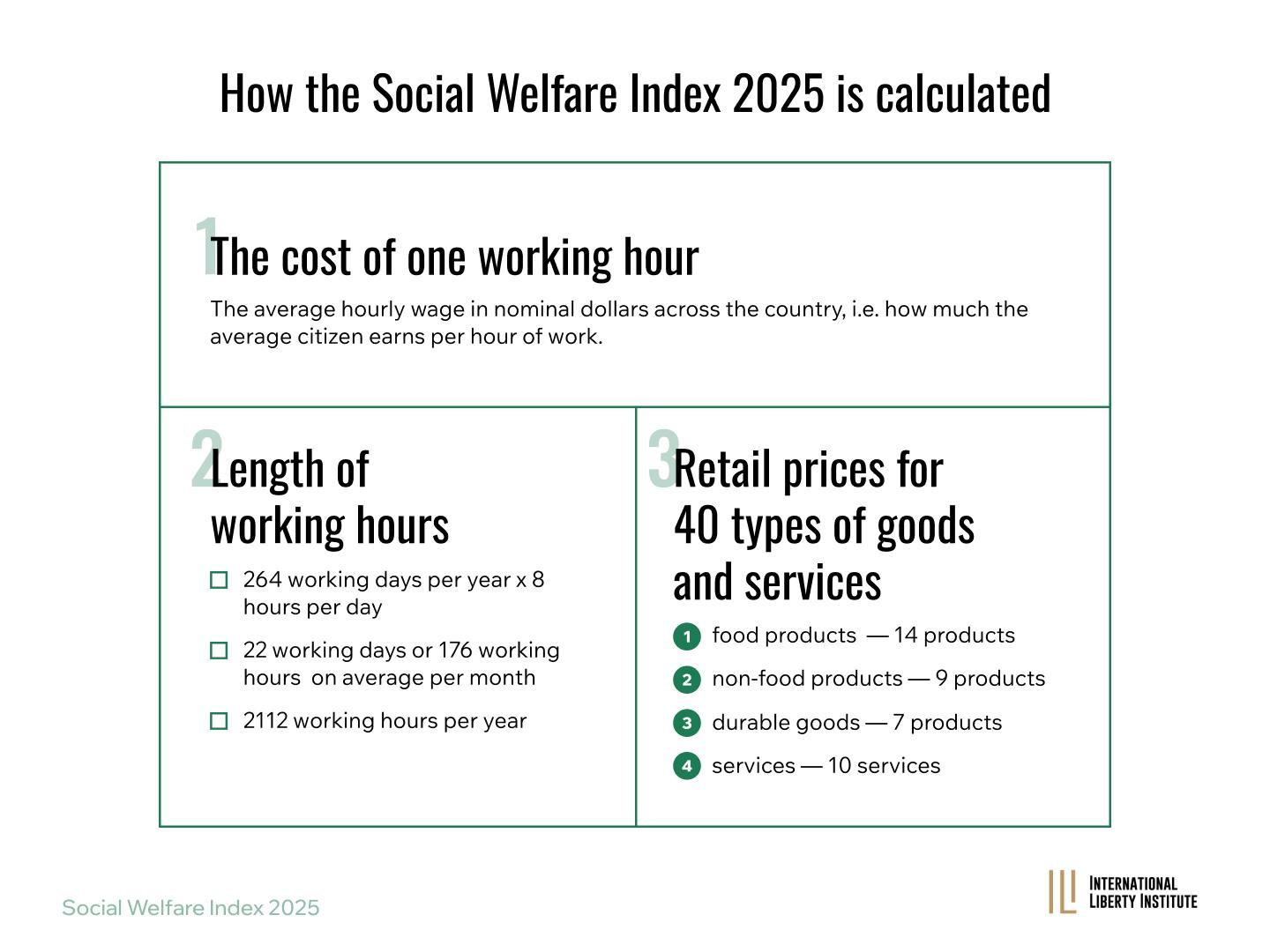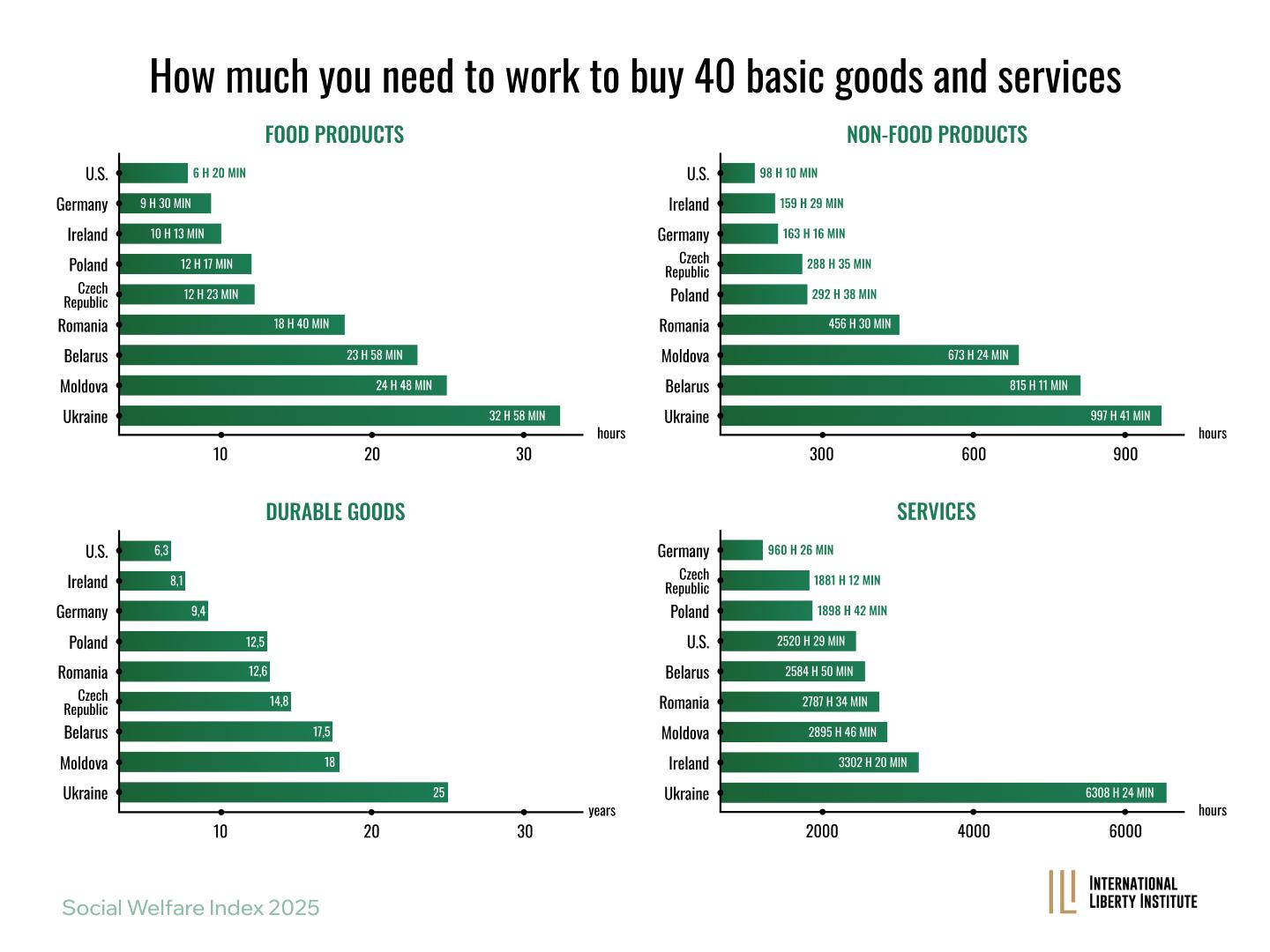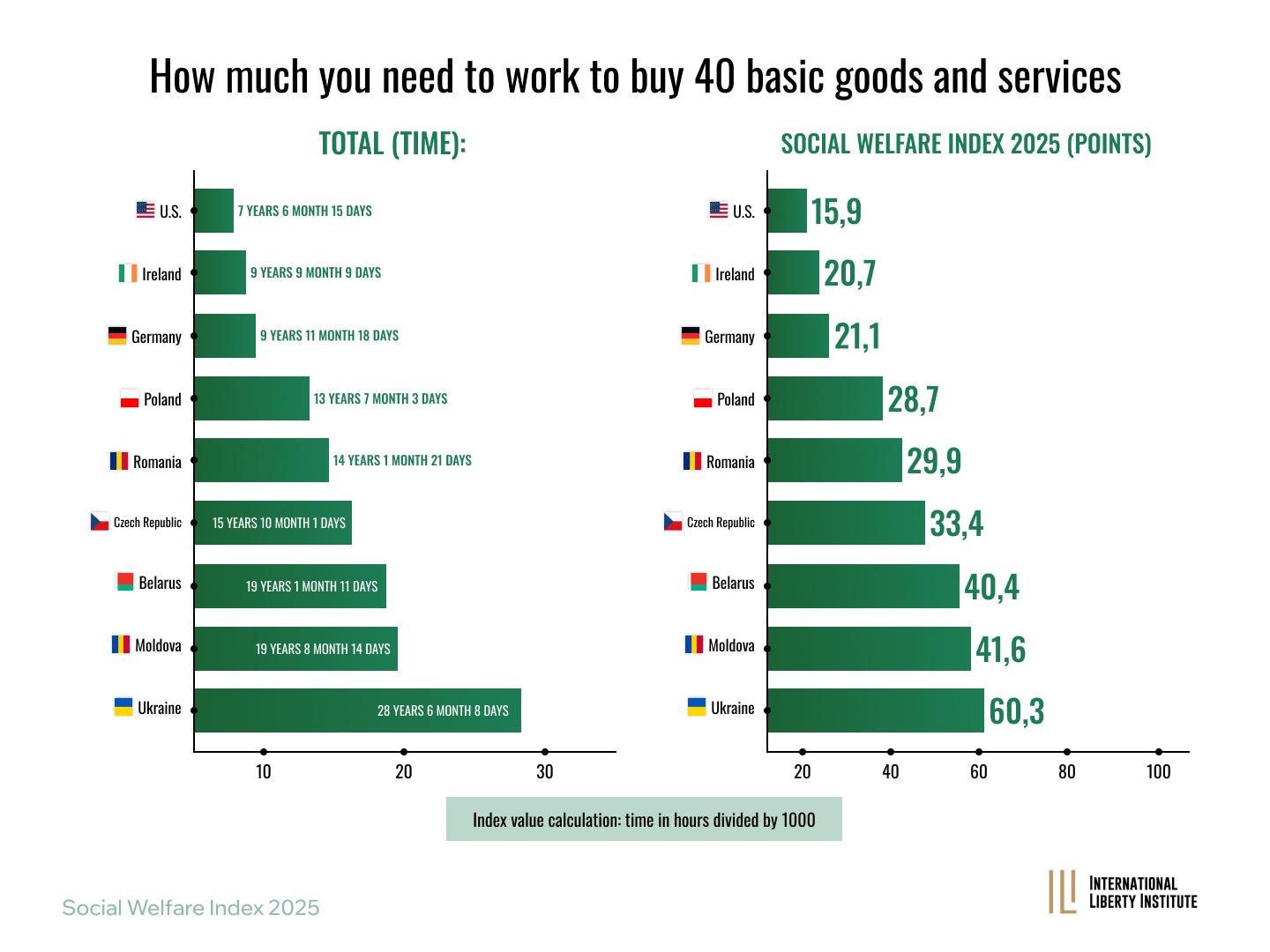Social Welfare Index 2025
Share Index



Summary
The Social Welfare Index, developed by the International Liberty Institute (ILI), measures the number of hours and years the average resident of a country needs to work to afford each of the 40 goods and services, as well as the entire proposed basket of goods and services.
The possibility of customising the Index, assessing the impact of the Government's actions and decisions on the Index, makes this tool useful for academic research, assessing the purchasing power of the population, taking into account real incomes and prices. The Index will help ordinary citizens understand the real economic situation, assess the quality of the government's work in eliminating poverty, increasing wealth, improving conditions for attracting capital, which is a prerequisite for increasing labour productivity and raising incomes, etc.
The Social Welfare Index is as close as possible to the real environment in which people live and work.
To ensure their own life and achieve a certain level of well-being, people have to work, i.e., they exchange their time, skills, competences, and knowledge for remuneration. The purpose of the Index is to measure the time spent by people in different countries and Ukraine to achieve a basic level of material comfort, as well as to indicate free time for other activities and enjoyment. The analysed data for more than 150 countries and numerous scientific studies of income dynamics lead to the following conclusion: the level of wages increases when a country has created and maintains sustainable legal and economic institutions to ensure rapid, long-term economic growth and development, the main of which are:
- private property
- economic freedom
- open competition
- free trade
- small state
- solidaristic, active civil society
The main way to eliminate poverty, increase the level of access to goods and services in a country with a transit economy is to move to the Mises-Hayek-Schumpeter model of entrepreneurial growth.**
Countries of the Social Welfare Index 2025
- Ukraine
- Poland
- Czech Republic
- Romania
- USA
- Ireland
- Germany
- Belarus
- Moldova

Assessment of well-being: work-life balance
- If a person needs to work less to buy the same set of goods and services than a year, two, or five years ago, it means that their level of well-being has increased and their quality of life has improved.
- Capital accumulation in the country, integration into value chains, and deregulation ensure the growth of incomes and wages. Maintaining such a regime for a long time reduces the burden of routine work, increases the chances of creative approaches, and improves the quality of the dialogue between society, business, and the state.
- The more a person earns per hour of work, the more free time he or she has for family, recreation, education, entertainment, hobbies, travel, etc.
Free time is a valuable resource that can be used to study, organize, and develop your business, and increase the market value of your personal intangible assets. This resource also stimulates a culture of saving. It is the most important indicator of quality of life.
Social Welfare Index 2025: results

In the 2025 Social Welfare Index, experts from the International Liberty Institute (ILI) compared nine countries around the world. The selection of countries for the Index was determined by the following factors.
The United States and Germany are benchmark countries that have been operating under the entrepreneurial growth model for a long time. Their main parameters are the rule of law, private property, economic freedom, open competition, small state, open trade, and unconditional operation of the profit-and-loss mechanism.
In the United States of America, to purchase 40 goods and services in the 2025 Index with just a “net” salary, you need to work for 7 years, 6 months, and 15 days, or 15,931 hours.

In Germany, to purchase the 40 goods and services in the 2025 Index, the average citizen should work 9 years, 11 months, and 18 days, or 2,085 hours.
That is 32.4% more working time of 2.4 years than in the United States. This difference is the result of Germany's lagging behind in terms of labor productivity and capital intensity, as well as the result of a higher tax and regulatory burden. The results of these countries give grounds to question the thesis that public investment in higher education, R&D, and other forms of human capital does not yield better economic and social results than the institutions and mechanisms of the free market and capitalism.

The best results and values of the Social Welfare Index 2025, among the European countries studied in the Index, are in Ireland: 9 years 9 months 9 days or 20.659 hours 41 minutes.
Ireland is an illustration of the benefits of the entrepreneurial growth model, natural, voluntary mechanisms and processes for poverty eradication and welfare improvement. In the early 1980s, Ireland was a poor country against the background to the leaders of the European Union, but in 2024, Ireland's GDP per capita was almost twice that of Germany. The Social Welfare Index 2025 also confirms the undoubted achievements of this country in improving the quality of life, improving the balance of “work-life outside of work”.
Ireland has found itself in the same group of social welfare alongside Germany, the United States, and other developed countries of the world, as a result of the stake of political, economic, and intellectual elites and society on economic freedom and capitalism.Share

The Czech Republic and Poland — examples of European countries that have become leaders in post-Soviet, post-socialist transformation. After eliminating the direct consequences of the Soviet institutional occupation, they mainly relied on the institutions of capitalism, economic freedom, and private property, and integration into the EU economic space. The results are evidenced by both the macroeconomic indicators of these countries and the data of the ILI Social Welfare Index 2025.
Poland. A citizen with an average “net” income should work 28711 hours or 13 years, 7 months, 3 days to buy a set of 40 goods and services in the Index.

Czech Republic. A citizen with an average “net” income in 2025 will have to work 33447 hours or 15 years, 10 months, 1 day to buy the same basket of goods and services.

The gap between beacon countries and post-socialist countries is a consequence of the difference in the amount of accumulated capital, the quality of institutions and the period of their functioning in a given country. Increasing the level of economic freedom, reducing the size and functionality of the state, closer integration into the international system of division of labor, provided that the population has access to the global financial market, is the way to reduce the gap between countries at an advanced level of transit from a centrally planned economy to full-fledged capitalism.
In Romania, to buy the 40 goods and services in the Index 2025 basket, you need to work 14 years, 1 month, and 21 days, or 29905 hours.

In Moldova, to purchase the 40 goods and services in the Index 2025 basket, you need to work 19 years, 8 months, and 14 days, or 41644 hours.

While Romania is actively catching up with systemic transformations, narrowing the gap with Poland and the Czech Republic, Moldova has not yet taken a clear course toward the free market and capitalism, and is lagging far behind even the leaders of systemic transformations in Central and Eastern Europe.
Belarus. To buy 40 goods and services, a Belarusian should work for 19 years, 1 month, and 11 days, or 40395 hours.

Belarus is an example of a state-planned economy functioning and of hyper-centralized clan-based governance. At the same time, a Ukrainian has to work 49% more time than a Belarusian.
The “Corruption Scheme” model is the reason behind Ukraine’s poorest performance.
Ukraine in the Social Welfare Index 2025
The long, persistent rejection of the institutions and mechanisms of capitalism, the free market and the principles of economic freedom for more than 30 years has led to the country's high risk of being trapped in poverty, low labor productivity, and poor institutions for economic growth and development.
Ukrainian elites have relied on the state of general interventionism. As a result, the institutions that ensure the country's defense capability have been weakened, and competitiveness and investment attractiveness have declined.
The hypotheses of supporters of the current economic model that such a huge size of the state is needed to overcome poverty, stimulate economic growth, and increase investment attractiveness are refuted not only by numerous statistical indicators, but also by the value of the Social Welfare Index 2025 for Ukraine.Share
Preserving the basic parameters of the Ukrainian economic model at the stage of both defending the country from Russian imperial aggression and after our victory would be a gross theoretical and practical mistake.

The monetary equivalent of Ukraine's total country time loss compared to Poland over the past 34 years is ~$4,530 billion, a time loss of ~330 million years.
If Ukraine had chosen the Mises-Hayek-Schumpeter model of entrepreneurial development in the early 1990s, and laid economic freedom, full private property, and small government as the foundation for development, the Ukrainian economy would already be worth more than one trillion dollars, more than five times more than in 2024.


Conclusions
The Social Welfare Index 2025 is not only the result of analyzing economic data for research purposes. It is a tool for assessing and adjusting the Government's economic policy, the agenda for political, intellectual, and economic elites to eliminate poverty, create high-quality, sustainable institutions to ensure rapid, long-term economic growth, and improve conditions for the formation of competitive human capital.
The 2025 Index makes it possible to identify those parameters of the entrepreneurial growth model that are most likely to ensure the path to social well-being within one generation, as well as the creation of an environment in which family capital is formed for many generations.
- To eliminate poverty, increase the level of access to goods and services in a country with a transit economy, the main way is to move to the Mises-Hayek-Schumpeter model of entrepreneurial growth. In this model, people get more time and opportunities to develop their human capital and ensure a harmonious work-life balance. The main components of the model are:
- private property
- economic freedom
- open competition
- free trade
- small government
- Active interventionism on the part of the Government shows significantly worse results in terms of poverty eradication and ensuring sustainable growth of the working population's incomes.
- It is critically important to “unleash” the Entrepreneur — through liberalization and deregulation of economic activity, the removal of administrative and legal barriers for investors of all types and sizes, and the reduction of the tax burden.
- Imposing minimum wage requirements on employers, working conditions, high payroll taxes, etc., do not ensure sustainable growth of labor productivity, “net” wages, and an increase in the “free time” resource for people, but increase the risks of “shadowing” the economy.
- Preferential treatment, granting preferences on a sectoral or regional basis, is not an adequate way to increase the material well-being of an employee. The regime of open, barrier-free competition for business is the best environment for lowering prices and increasing the “net” salary of an employee.
- State dominance in the economy and extensive state regulation may yield worse results than an authoritarian regime with a high level of economic freedom, limited interventionism in commercial activities of the state, and protection of private property rights, including for small and medium-sized businesses.
Download Index
Download the report 
